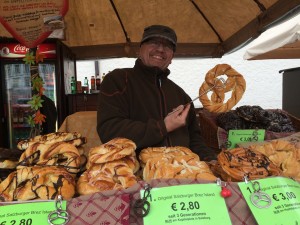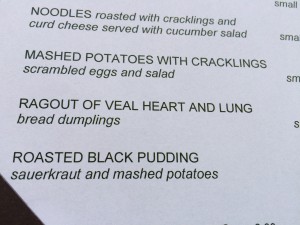The Austrian Paradox
 You’ve heard of the French paradox, of course: All those annoyingly svelte citoyens de France who breakfast on croissants and pain au chocolat, slather their baguettes with runny Camembert while slicing off slabs of fois gras, partake of profiteroles and tarte tatin – and stay (annoyingly) svelte. Not to mention more-than-annoyingly smug.
You’ve heard of the French paradox, of course: All those annoyingly svelte citoyens de France who breakfast on croissants and pain au chocolat, slather their baguettes with runny Camembert while slicing off slabs of fois gras, partake of profiteroles and tarte tatin – and stay (annoyingly) svelte. Not to mention more-than-annoyingly smug.
The “paradox,” first noted in the late 1980s (60 Minutes placed it on our radar in 1991), was based on the epidemiological observation that French people eat diets rich in saturated fats but have a relatively low incidence of heart disease (an apparent contradiction to the widely accepted belief that high fat diets are a significant risk factor for heart disease). How do they do it, we fat-loving, decidedly un-svelte, walking-heart-attack Americans wanted to know.
The much-ballyhooed French “secret” was thought to be red wine. Drink enough of it, and it doesn’t matter how many goose livers and éclairs you consume. Just so you know, Americans’ consumption of red wine skyrocketed since the “paradox” was revealed. (We drink more wine than anyone else on the planet and more than twice the amount we did pre-paradox.) While we were drinking all this wine, our obesity rate jumped from 15 percent (1990) to close to 40 percent (2015). While we were drinking this wine, we held onto (and increased) our lead as #1 in heart disease among the “high-income countries” (western Europe and North America). So maybe it’s not the wine?
Which brings me to…the Austrian Paradox. I am writing this from Vienna, city of the Sacher Torte, of the everything mit schlag (that’s cream), of beer, of breakfasts of bread, cheese and meat, of meat, meat and more meat. Here’s the menu from the restaurant I went to a few nights ago. This is where I mention that Austria’s rate of obesity is less than half that of the U.S., as is its rate of diabetes. Austrians are half as likely to die of heart disease as we are. Yet they are bread, cheese and sausage eaters (and then there’s that strudel) who mostly seem to shun vegetables. And they drink a lot of beer. And they smoke at more than twice the rate we do.
This is where I mention that Austria’s rate of obesity is less than half that of the U.S., as is its rate of diabetes. Austrians are half as likely to die of heart disease as we are. Yet they are bread, cheese and sausage eaters (and then there’s that strudel) who mostly seem to shun vegetables. And they drink a lot of beer. And they smoke at more than twice the rate we do.
Vas ist los?
We want the secret.
Okay, here’s the secret: The Austrians, the French… they live very different lives than we do. It is not one thing; it is everything. It’s lifestyle. They walk or bike to work, to shop, to do errands, to visit friends, to go to the museum. Kids walk or bike to school. Old people, really old people, walk everywhere. You see old people making their way up impossibly steep flights of stone steps, riding bikes, arguing politics in cafes.
The automobile is not a way of life. I’ve yet to see a drive-through. The idea of zipping through a kiosk to get a greasy bag of food to eat in the car is as bizarre to them as not owning a car is to us. (Yes, they do have McDonalds.) They don’t snack on garbage food from machines all day. Although I would not make the case that either the French or the Austrians have a full-blown “dolce vita” or “pura vida” attitude toward life, they sure seem to enjoy their lives, inhabit them, live them fully in a way we don’t. (As an aside, I’m currently on a Westbahn train full of commuters – and I am the only one on a laptop working.)
So if we are going to learn any lessons from the Old World, let’s look beyond red wine or good fat v bad fat. Let’s look at life.






9 comments
Love it! I would add:
1. “The automobile is not a way of life” – while that observation is certainly true for Vienna, I would be cautious to say that it is true for the rest of Austria.
2. Apart from eating, walking and biking, I wonder what effect (too much) work has on health and obesity. As you’ve observed on Westbahn (ugh!), compared to western Europeans, Americans work more hours on average and have less holidays. (has anyone done a study on it?)
3. http://austrianadaptation.com/28-ways-to-be-austrian/
I am definitely going to get some stats for this. I know you’re right about fewer holidays and longer work weeks. I’m going to look for research on health effects (aside from stress…but then there’s stress eating, so maybe that’s it?)
I love this post! I also wonder about the portion sizes of the menu items (with CRACKLINGS!)–it seems that the US standard of what is a serving is so much more than the European or Asian view. Arguably cracklings in moderation might be OK?
Now I have to go look up with cracklings are, but I think they are some type of deep fried fat.
I think you’re right about portion size. At a restaurant with Daniela, I was served tuna on top of pasta — like a 1/2 cup of pasta, aka “one serving.”
I’m betting that consumption of packaged processed foods is far far lower.
Maybe packaged food in general, Barb.
Great Post! To the comments already made I would add what I noticed during my stay at a Canadian family when I was a teenager: Austrians/Europeans have more homemade meals. They very rarely have take away or fast food for dinner at home.
Good point, Lisa. I’m going to look up statistics on at-home meals. Take-out is HUGE here.
I did not see an email for you but just finished reading Raising the Barre. LOVED!!! I started ballet classes about 25 years ago and still with it. I think I have read every book about ballet over the years and yours is the BEST!!! It was so REAL with great humor and great info on many levels made the read so valuable on many levels. Just wonderful. Cant wait to read all of your posts here.
Leave a Comment